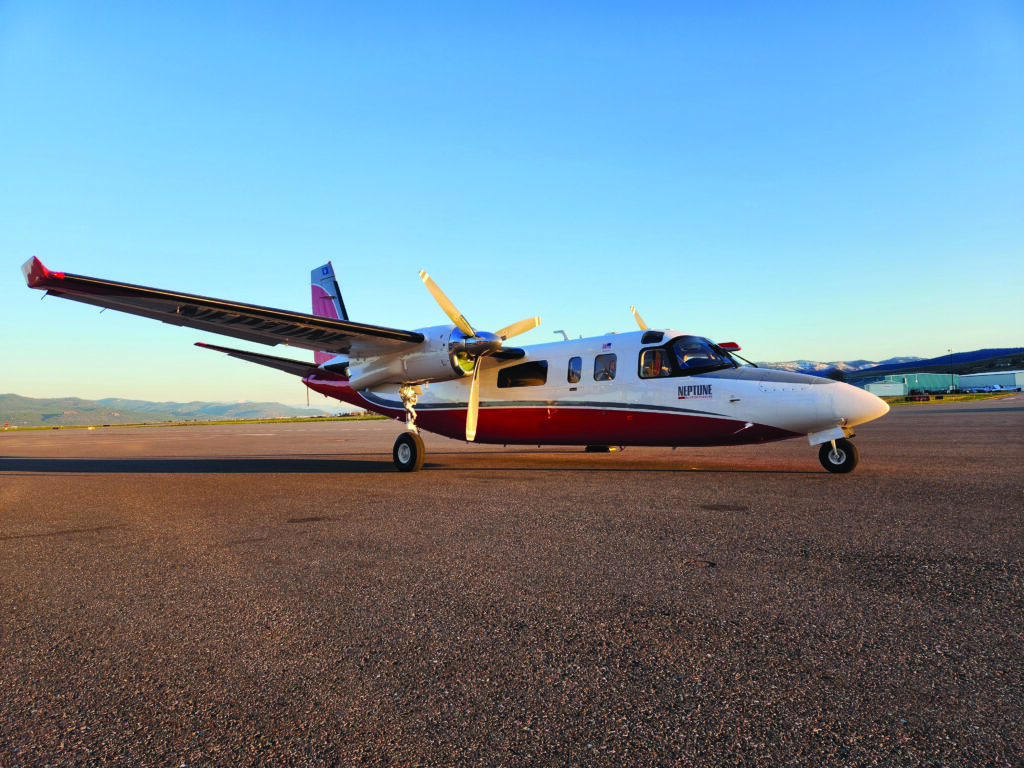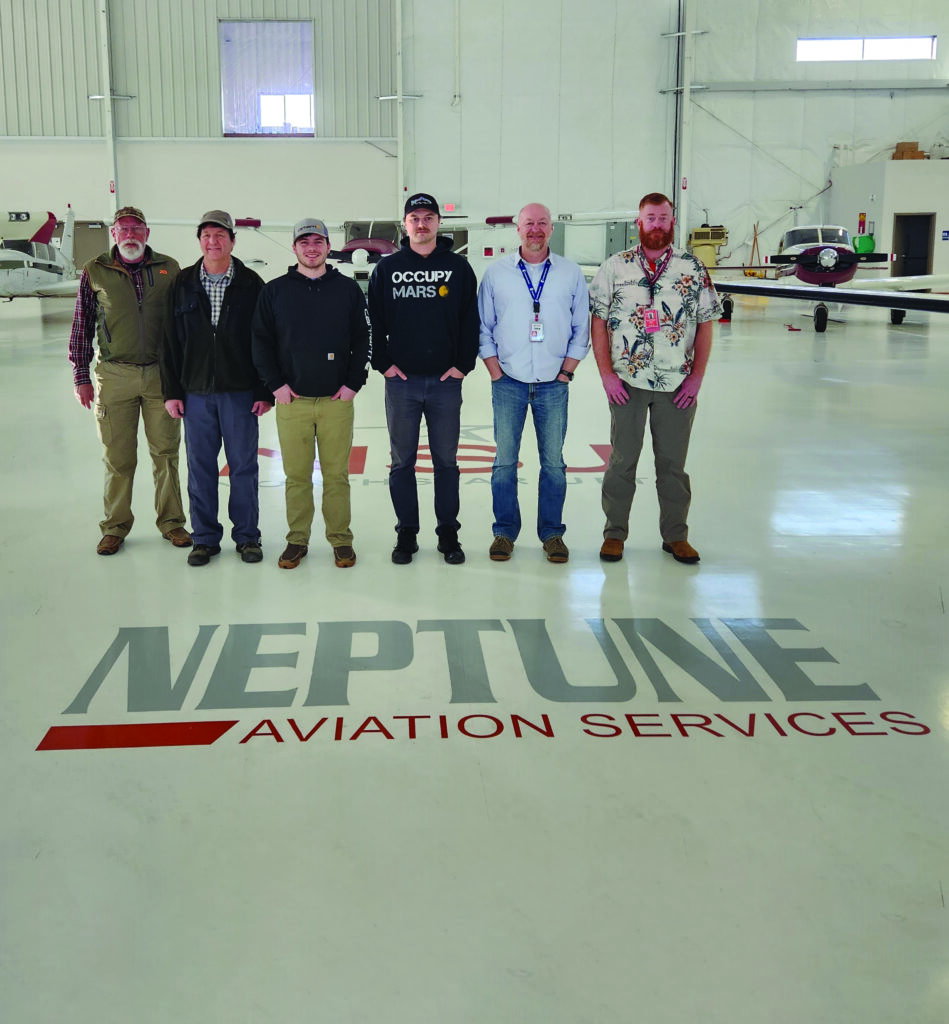Neptune Aviation Services is going beyond its well-known air tanker operations with plans to offer air attack services by June 1 of this year, deploying two Rockwell Aero Commander 690A twin turboprops. The aircraft was previously operated by the air attack division of Northern Wings Aviation of Bozeman, Montana. Neptune, which purchased the Northern Wings operation last year, has rebranded its Neptune Aviation Services Air Attack.
According to Neptune Aviation Services’ President Jennifer Draughon, the primary mission of the aircraft in the air attack mission will be to coordinate the movement of air assets such as tankers, lead planes, and helicopters deployed over fires, as well as to communicate with fire incident commanders on the ground. Other roles will include wildfire mapping and fire surveillance.

A Critical Business Move
Draughon reported that entering the air attack sector of aerial firefighting was a natural move for Neptune, whose current air tanker fleet consists of nine BAe 146 jets formerly used in commercial passenger service and reconfigured as air tankers.
“It was critical that we transition into this line of business—smoothly and successfully—and then work to expand it,” said Draughon. “After performing our due diligence with pre-buy inspections of airframes, company performance, and other business evaluation reviews, we concluded that because of Northern Wings’ small size, it was manageable as a new line of business and diversification effort for Neptune. At the same time, it came with existing US Forest Service (USFS) contracts and was recommended to us by one of our employees who had worked there in the past.”

The two Aero Commanders are currently under call-when-needed (CWN) contracts with the US Forest Service (USFS) Region 1, covering Northern Idaho, Montana, North Dakota, and a small part of South Dakota.
Expanding a business beyond its core product or service might be considered risky for some companies. Yet, as Draughon noted, the business case for adding air attack to Neptune’s highly specialized large air tanker-fire retardant dropping operation was two-fold.
“One aspect of the diversification is to provide our customers with more answers to the solutions they seek—from a source they know and trust,” she explained. “As we expand internationally, the aerial firefighting contracts, we have noted, often seek a one-stop package approach. In that regard, we want to be able to offer the best solution possible for the contractual requirements being sought.”
A Pilot Recruiting Draw
Draughon added that expanding into air attack services also presents an excellent opportunity for pilot recruitment. “This allows us to bring in pilots and have them gain experience in the fire traffic area, be mentored under the expertise of our pilots, and learn the environment and Neptune’s culture with the idea of moving into the airtanker platform,” she stated. “Air tanker pilots are a highly-skilled, unique group of professionals that are hard to come by, so we see the air attack platform as the potential to build our pilots.”
“Our entry into air attack accomplishes many goals,” stated Tim Mead, Lead Pilot-Air Attack for Neptune. “It’s a great extension for our aerial firefighting tanker business, allowing us to develop a deeper talent pool of pilots specializing in aerial firefighting.
At the same time, he explained, it gives pilots a career path to move from their general aviation experience to air attack and tanker pilot. “They will have the opportunity to tap into the tanker team’s knowledge and expertise in terms of fire behavior, communication with the tanker pilots, and the needs of the firefighting team on the ground,” he noted.![]()
![]()
All training of the air attack pilots, reported Mead, will be handled in-house by Neptune’s instructors.
“It was important to integrate air attack training into the training system that we use for pilots throughout the company,” he said. “When you think about Neptune’s 30 years of experience in training tanker pilots in-house, it made sense for us to train our air attack pilots. Also, since Neptune tanker training standards have been incorporated into the air attack training, that will make it easier for pilots to advance from air attack to tanker operations.”
Mead added that the aircraft would be the primary device for ground and flight-based pilot training. Specifically, a minimum of 25 hours will be performed in the airplane, following 54 hours of ground instruction. Mead and one of the former Northern Wings pilots will handle training for the air attack operations.
Air Attack Is Intense
Asked to cite how the air attack mission differs from those of the air tankers, Mead explained that, for starters, the level of communication activity in an air attack aircraft during a fire scenario is intense.
“There are as many as six different radios on the aircraft, and during air attack, the USFS Air Tactical Group Supervisor (ATGS) who rides with our pilot, coordinates incident airspace, manages the incident air traffic, and is the link between ground firefighters and the aerial assets. Our pilots must understand the airspace and the ATGS’s needs to locate the aircraft in a safe and efficient position over the fire to support the mission,” he said.

“It’s our job in air attack to make the ATGS’s life as easy as possible while operating over a fire, which is why our pilot training puts a premium on the ability to communicate.”
Mead pointed out that air attack pilots fly the aircraft solo, unlike an air tanker, which operates with two pilots. “There are other team members onboard the aircraft, but only one pilot,” he said. “For the air attack pilot, that adds an additional level of responsibility for making decisions about safety, flight operations, and conditions over the fire.”
He also noted that air attack pilots fly in a confined, low-level environment, while tanker pilots fly even lower and within even more confined spaces. “Both Neptune training models reflect the different environments in which the pilots fly and prepare them for the rigors of flying in a wildfire environment,” he said.
Adding Air Attack Was Relatively Easy
According to Nic Lynn, Neptune Aviation Service’s Vice-President, Operations, adding air attack to Neptune’s portfolio of services was relatively simple.
“Air attack operations are conducted under FAR Part 135 regulations, and since Neptune has had a Part 135 operation for the past 15 years, adding the aircraft and mission to our organization wasn’t a big challenge,” he said. “While it differs from our Part 137 air tanker operations, our air attack program will benefit from our existing Part 135 and Part 145 organization’s administration, leadership, and maintenance personnel. We will have five trained and USFS-qualified pilots to support the two Aero Commanders, including three we hired directly from Northern Wings. We have the people and the certifications to stand up this new mission.”
As with its BAe 146 tanker fleet, Neptune will maintain the Aero Commanders in its Missoula Airport (MSO) maintenance facilities. A product of the Aero Commander Division of the long-gone North American Rockwell Corporation in the 1970s, Lynn said that the airframes and engines would be maintained in accordance with the maintenance and inspection programs of the original equipment manufacturers (OEM). For the Garrett AirResearch TPE 331-5-251, the OEM is Honeywell. The Aero Commander 690 aircraft is supported by Twin Commander Aircraft, LLC. He said Twin Commander has been very supportive of the airframe to date. Neptune’s Aero Commanders have an average age of 48 years and 6,500 hours on the airframe. With no major inspections due at this time, they were ready for deployment in June of this year.
![]()
Adding Aircraft
Neptune, of course, sees air attack as a growth opportunity. Along that line, Draughon reported that expanding the air attack fleet is definitely in the company’s carefully crafted strategic planning.
“We will be expanding the fleet. Neptune’s model of expansion has always been methodical, taking into account all factors foreseeable for success well into the future,” she said. “As we study our growth model, we will be looking at bringing new technology to the airframes and exploring the different platforms that bring the greatest safety, efficiency, and effectiveness at an affordable price point for our customers.”


